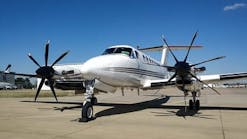Equipment Maintenance
By Jim Sparks May 2000Manufacturers of aircraft and of avionics equipment generally provide guidance to assist in keeping their equipment operating properly. This may include information for functional tests, bench tests and even proper handling techniques. In addition, Advisory Circular 43.13-1B provides a wealth of data that manufacturers may not include, for example something as simple as defining different types of inspections.
A Visual check generally needs no explanation as most in the industry realize this will involve looking at the physical condition of the components and checking for any defects such as corrosion, tightness of attaching hardware, and proper safety. Also included, but often overlooked, is the identification of placards. Placards regarding system operation or component description that are worn or missing should be renewed or replaced.
An Operational test should always be carried out after specific system maintenance or component removal. A qualified technician should always carry this out — one who is familiar with proper system/component operation and who can recognize any peculiarity. The data used for operational tests is available in most cases from the aircraft Flight or Operating Manuals. Some operational tests may require the aircraft to be in an "In-Flight" environment and can require either jacking the aircraft or somehow "fooling" the ground/flight sensing system. There are also situations where temperature change may have an effect on operation. In an environmentally-conscious society, it is no longer acceptable to spray Freon at a component to reduce temperature. There are several atmosphere-friendly materials that can be used such as carbon dioxide and of course, where possible, a bag full of ice cubes. A heat gun or sometimes a hair dryer can be used. The effects of excess heat or cold should always be considered prior to the application and proper safety measures should be implemented.
Functional tests are often confused with Operational tests but by definition have a significant difference. A Functional test, like an Operational test, should always be performed by a qualified technician. Unlike an Operational test, a Functional test is conducted to verify the calibration and accuracy of the system or device. Frequently, test equipment and manufacturers' technical procedures are needed — an example of this would be an Altimeter or Transponder check.
The Bench test is used only after a component has been removed from the aircraft. This is necessary after a component fault has been recognized and adjustment or repair is required. Frequently after a Bench check, either a Functional or Operational test should be conducted after component reinstallation.
Inspect equipment racks.
Interference tests are another consideration with any electric or electronic equipment installation. All mechanical and electrical connections should be checked for proper installation in accordance with manufacturer recommendations. Another consideration is the temperature rating of the wire insulation in different areas of the aircraft. Worst case situations should always be evaluated. Testing of equipment should be conducted using the aircraft's power generating system and with all associated electrically operated equipment and systems operating unless otherwise specified. With the component/system under evaluation operating, activate other equipment one system at a time to verify no significant radiated or induced interference occurs. Reasonable combinations of control settings and modes of operation should be evaluated. For communication and navigation equipment testing should be accomplished using at least one frequency selection in a high, mid, and low frequency band. It is often advantageous to make note of certain system combinations that should be observed during a dedicated non-revenue test flight. Electromagnetic incompatibility may result from design characteristics of previously installed equipment.
Unfortunately, the facility installing a new system is usually responsible for resolving any conflicts which develop with the addition of equipment.
Ground Electro Magnetic Induction (EMI) testing has been found adequate for installation of similar types of equipment. Devices such as wireless telephones or any device that transmits radio frequencies will need to be tested to verify lack of interference with other aircraft systems. As an example, during the initial installation and certification of a High Frequency (HF) communication radio on a business jet using an Electronic Engine Control (EEC), it was noted that anytime the microphone was keyed for transmission purposes both engines would FLAME OUT — obviously not a condition conducive to safe flight. The engineers were then forced back to the drawing board to determine where the HF signal was being induced and then to decide whether to filter the transmission or shield against the reception.
Soldering equipment.
Handing procedures and techniques
Electronic equipment manufacturers frequently publish "Handling" Procedures or Techniques for their specific equipment. Any component containing electronic devices such as diodes, transistors, or integrated circuits should be protected from Electro-Static Discharge (ESD). For example, Intertechnique, an electronic equipment manufacturer for numerous aircraft, provides a list of "General Handling Rules." These include:
1. Avoid having non-conductive items such as trays, bags, packaging material, drawings, or personal effects that are not essential for the work at hand within the immediate area of the component.
2. Only use appropriate gloves or finger protection when handling Electro- Static Sensitive Devices (ESSDs).
3. Prior to removing any component from a conductive package, the technician should first touch the package. This also applies to re-packing the device. Care should also be taken to insure that the electrical terminals on the device do not come in contact with any plastic or paper outer containers.
4 . If it is necessary to place an electronic component on a conductive workbench without a protective cover on its terminals, it should always be done with the terminals in contact with the conductive surface.
5. Technicians are reminded that ESSDs can be destroyed by only momentary contact with any non-conducting or ungrounded object and that the damage is inflicted at the moment of contact.
6. Technicians should also be aware that the use of conductive surfaces in Special Handling Areas (Static Free Rooms) departs from the normal procedure of electrically insulated work surfaces and appropriate care should be taken so that unauthorized electrical equipment is not used in the proximity of the work area.
7. Protect removed components against Electro-Static Discharge. 8. When soldering, heat should be confined as much as possible to a limited area. This can be done by using temperature-controlled soldering irons and heat sinks.
Suitable test equipment is essential to safe maintenance of airborne avionics systems and it is up to the certificated technician to make sure the test equipment calibration standards are met and traceable. In the United States, for example, the standards are from the National Institute of Standards and Technology (NIST) or an established test equipment manufacturer. In all cases, test equipment used must meet with the approval of the FAA if the test is used to satisfy an Airworthiness Requirement. It is also up to the technician to verify that the test equipment is capable of performing all parameters of the required test and that the level of accuracy is sufficient. Frequently, airframe and avionics system manufacturers will provide a list of recommended test equipment for accomplishment of different tasks.
Keep calibration of equipment current
The calibration of test equipment will vary with the type of equipment and possibly even the environment in which it is used. As a general
rule, a one-year interval is acceptable; however, manufacturers' recommendations and even past calibration history may have an impact on recertification. The local airworthiness authorities also have some valuable input on determining test equipment calibration intervals.
Each aircraft, along with system manufacturer, will devise their own specific system testing particulars. There are, however, certain general rules that will apply to the majority of aircraft.
In addition to checking the adherence to bonding requirement, wires and cables should be checked and kept as short as possible except for those antenna cables that are set to a specific length. All components should be free of dirt or other contaminants, and ventilation systems and openings should allow proper airflow. Circuit breakers and electrical switches should be checked for proper operation. It should be considered that a spring-loaded switch might experience internal failures preventing it from tripping off or even failing to open the assigned electrical circuit. It is also important to note that improper switches or circuit breakers with improper ratings or properties have not been substituted. As an example, circuit breakers used in AC circuits are not designed to carry the same current as those used in DC systems.
Mounting racks
One often overlooked component when conducting inspections on avionics is the mounting rack. In addition to looking for the standard condition and structural integrity, particular attention should be paid to any mechanical shock suppression device. Vibrachoc makes one type of spring-loaded shock absorber, and like any spring-loaded device, these are apt to lose their tension with age. A simple test recommended by Vibrachoc is to measure the distance from the rack to the supporting aircraft structure, then compress the mount complete with component installed. Once compressed, re-measure. If the loaded measurement is within .039 inches (1 mm) of the at-rest measurement, the device should be replaced.
Antennas
Also in the inspection process, other often overlooked items are the
antennas. In the case of single wire devices, they should always be checked for the condition and presence of insulators and springs. Other surface-mount antennas should have crack-free housings, and if the leading edge is protected, it should be with an anti-static coating. Proper bonding is also essential to correct operation. Some equipment useful in determining proper antenna operation is a Time Domain Reflectometer (TDR), which will pinpoint defects in the coax transmission line as well as internal defects in the antenna. A Wattmeter in line with a transmit- type antenna can also be useful to determine true system output.
Static wicks can also have adverse influence on aircraft electronic systems. In addition to checking security and mounting, wear and abrasion is also accountable for deterioration in the ability to discharge unwanted electric charges. The bonding of bases to aircraft structure should insure no voltage level difference between the two surfaces. If the aircraft has pitting on the surface under the metal base for the static wick, it is likely that it experienced a lightning strike. In the event of a confirmed lightning strike, removal and inspection of all static discharger mounting surfaces is a worthwhile precaution. Routine megohm checks on individual wicks may also be useful in heading off unwanted precip static conditions.
Technician is inspecting circuit breakers. Be sure to also include pull and reset.
Basic rules
Some basic rules pertaining to avionics systems in general include dealings
with compass systems; a compass swing is considered a functional test. This should always be performed when a new compass or compass system component is replaced. Some other considerations on conducting a compass swing would be anytime the accuracy is in question and in the event of aircraft modification where ferrous metal is installed in the general area of the compass magnetic sensor. Should the aircraft experience a lightning strike, severe turbulence, or a hard landing, a functional test of the compass would be in order. Also, anytime a change is made in the electrical system that may cause a change in the aircraft electromagnetic field would require compass testing.
A geographical change in aircraft operation can have a major effect on magnetic deviation as can the hauling of ferrous metal. More sophisticated compass systems will be less affected by these changes, and compensations could be made with a selector in the flight compartment. A compass swing should also be part of the de-preservation checklist anytime an aircraft is put back in service after being in storage.
Each communication, navigation, or auto-flight system will have specific tests necessary to verify airworthiness. Of course, particular attention should be paid to manufacturers' inspection requirements and techniques as well as Federal Airworthiness guidelines, but keep in mind, one good source of general non-specific information is Chapter 12 of Advisory Circular 43.13-1B. Although it contains basic data, this useful publication can often provide the technician with enough information so that specific questions can be presented to the experts.








